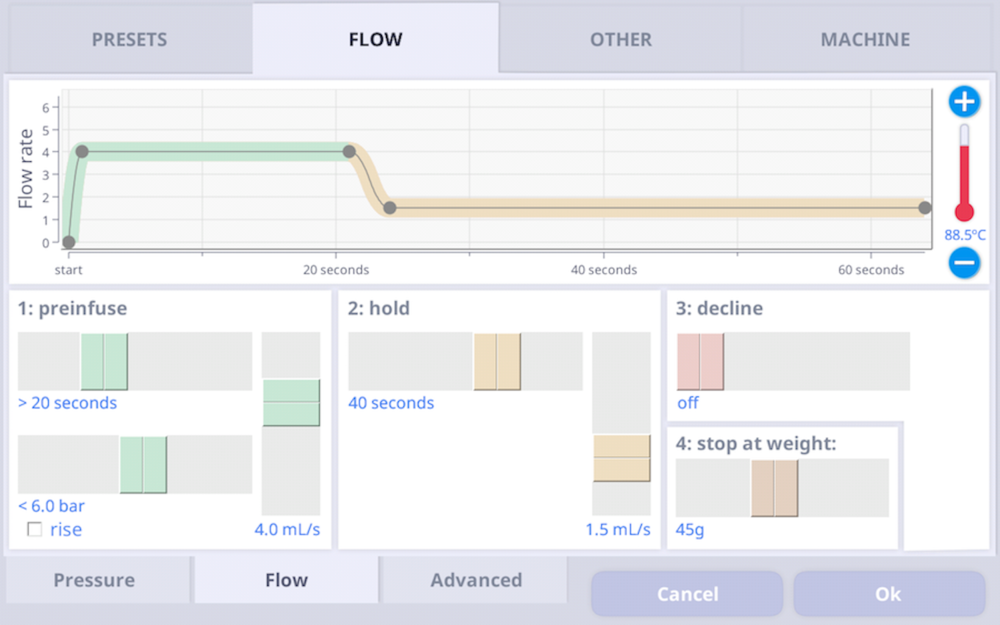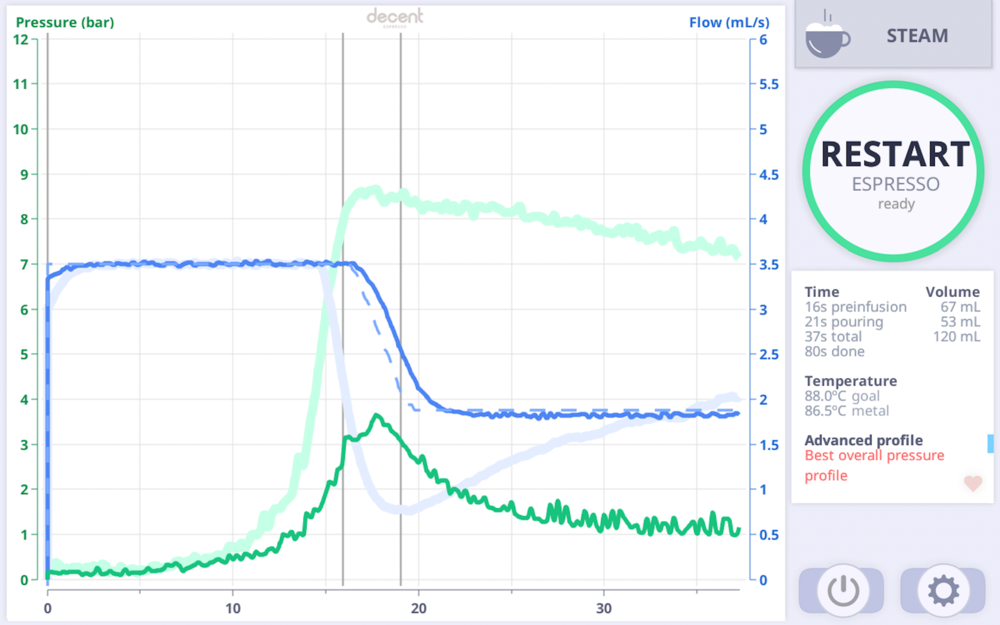Flow Profiling on the De1+ - a podcast by Scott Rao
from 2018-06-29T11:08:15
Probably the most exciting feature of the DE1+ is its ability to manage shots by flow rate. That may not sound like a big deal, but read on to have your mind blown.

The flow mode recipe screen. It's simple and intuitive.
Most espresso machines apply a steady amount of force to the coffee puck, the puck provides resistance, and the resulting flow rate rises as the puck erodes due to extraction. In my experience, this dynamic leads to erratic flow paths late in a shot, regardless of the quality of the barista’s puck prep. Uneven flow through a puck is akin to lots of mini channels, and, like larger, more obvious channels, it decreases extraction and increases bitterness and astringency.
Pressure profiling machines allow the barista to vary the pump’s applied pressure. The classic, competent pressure profile I had written about in my ebook Espresso Extraction: Measurement and Mastery was inspired by the profile of a lever machine, and includes preinfusion and a pressure ramp followed by a pressure decline. The pressure decline in the latter half of a shot can prevent the flow rate from rising as the puck erodes. With such a pressure profile, if the grind setting and puck prep are skillfully executed, the result will be a relatively constant flow rate and minimal channeling.
In flow mode on the DE1+, the machine manages the output (flow), not the input (pressure), which is a big step forward for repeatability. It does this by varying the pressure up 6,000 times per second (not a misprint) to trace a programmed flow curve. Flow mode takes the pressure (sorry) off the barista to provide the perfect puck prep and grind setting. Don’t get me wrong: skilled puck prep and setting the proper grind are still important. But pulling shots in flow mode compensates somewhat for imperfect puck prep and grind setting.

DE1+ screen view showing the pressure, flow, and temperature curves of a flow-profiled shot.
How is that possible? In flow mode the DE1+ “fixes” channels. That may seem too good to be true, so let me explain. When a typical espresso machine’s pump delivers constant pressure and a channel forms, the puck’s resistance decreases. A channel allows higher flow as lots of water bypasses the more densely packed areas of the puck. The extra flow through the channel causes it to enlarge, setting off a vicious cycle of lower resistance causing higher flow and a larger channel, leading to even less resistance. When a channel forms in flow mode on the DE1+, the pump slows in order to maintain the desired flow rate, and therefore doesn’t exploit the channel as aggressively. We have found that as the pump pressure decreases in flow mode, the grounds rearrange themselves, decreasing the size of the channel. As grounds shift into the channel, it shrinks, the puck’s resistance rises, and the pump pressure increases again to maintain flow.
Flow mode may not improve a great barista’s best shots (though it probably will), but it improves the majority of shots, even by good baristas, and can dramatically improve the quality of shots pulled by average and poor baristas. I see flow mode as an incredible tool for restaurants and chain coffee shops where baristas may not be as skilled as those at the better third-wave shops.

A flow shot with the grind too coarse in a mediocre home espresso grinder. Note how the pressure curve (the green line) peaked at only 3.5 bar. That implies the grind was too coarse, but the DE1+ prevented the shot from gushing and running too fast.
Although I think flow mode is an incredible advance, it can be a crutch, and like any crutch, it will be up to the barista to not rely on it excessively. For example, if a barista creates a flow profile, aims for a 20g in/ 40g out/ 30-second shot, and sets the grind five notches too coarse on a Robur, the shot will take approximately 30 seconds and the extraction will be low. However, the result will be superior to the 10-second “gusher” that such a grind would create in pressure mode or on a standard “dumb” espresso machine. The gusher will also extract too low but will have far more channeling, bitterness, and astringency than the shot pulled in flow mode. To distill the difference down to one critical point, the flow shot will extract much more evenly than the pressure shot.
Mind blown.
Further episodes of Q
Further podcasts by Scott Rao
Website of Scott Rao